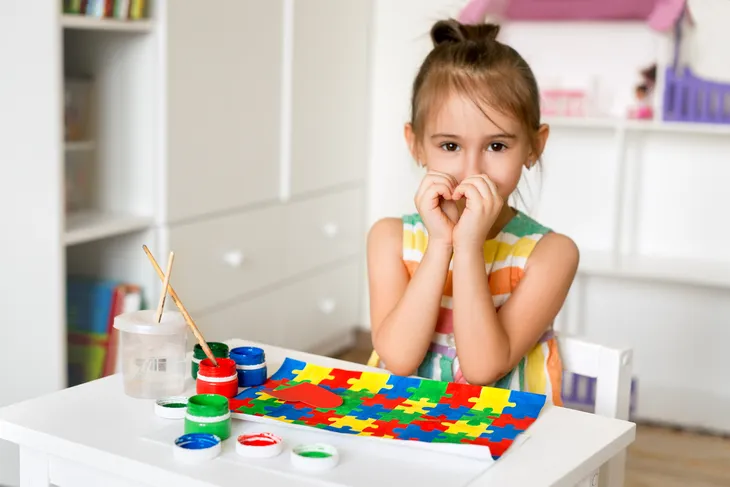- Autism spectrum disorder refers to a broad range of conditions characterized by challenges with social skills, repetitive behaviors, speech, and nonverbal communication.
- Common signs are lack of emotion, poor eye contact, speech delay or regression, repetitive movements, and unusual sensitivities, fixations, and/or preferences.
- Parents with concerns about development (i.e. the way their child plays, learns, speaks, or acts) should talk to their doctor.
Most people have heard of autism spectrum disorder (ASD) and many might even know someone with autism. Affecting an estimated 1 in 44 children in the U.S. today, ASD refers to a broad range of conditions characterized by challenges with social skills, repetitive behaviors, speech and nonverbal communication, explains Autism Speaks.
ASD typically appears by the age 2 or 3, and sometimes as early as 18-months. Research shows early intervention leads to positive outcomes later in life, so its imperative parents are informed on all the warning signs of ASD. To help, here’s an in-depth list of key characteristics that could indicate a child is on the spectrum…
What is Autism Spectrum Disorder?
Researchers are still learning a lot about autism, but what is known is that it’s a developmental disability caused by differences in the brain, says the Centers for Disease Control and Prevention (CDC). Sometimes this difference is known, such as a genetic condition, while other times it’s unknown. It’s believed there are multiple causes of ASD that when combined can change the ways people develop.
People who have ASD may “behave, communicate, interact, and learn in ways that are different from most people,” writes the source. The abilities for people with ASD can also vary significantly. For example some people with autism may have advanced communication skills whereas others are nonverbal. Some need a lot of assistance in their daily lives, and others live with little or no support. According to the CDC, ASD begins before the age 3 and continues throughout a person’s life, but symptoms may improve over time.
What Causes Autism?
Unfortunately, there is no known cause of ASD. The only research-based cause known to experts is genetics. This plays a large role in the majority of cases, says Autism Speaks. This means parents who have a child with ASD are more likely to have a second child who is also affected. Also children born to older parents are also at an increased risk.
Researchers are currently exploring whether environmental factors play a role in either influencing or reducing autism risk in people who are genetically predisposed. It’s important to note that extensive research has been done on whether or not vaccinations cause autism. The consensus around this has been clear — vaccines do not cause autism, says Autism Speaks.
Each Child is Unique
Of course every child is unique in their own way and this rule also applies to autistic children. The symptoms of autism can vary greatly from child to child. Some will show signs in early infancy, whereas others develop normally until the age of 2 or 3, explains the Mayo Clinic. It’s not until this point that they become withdrawn or aggressive, or start to lose language skills.
According to the source, the level of severity (from low to high functioning) varies from child to child. Each has their own unique pattern of behaviors. Some have difficulty learning, whereas others learn quickly and show high levels of intelligence, but have trouble communicating and applying their knowledge in everyday life. They might also struggle adjusting to social situations.
Severity is usually determined on the level of impairments and how they impact a child’s ability to function, notes the Mayo Clinic.
Social Communication and Interaction
Avoids Eye Contact and Affection
A common indicator of ASD is avoiding eye contact or poor eye contact. HealthyChildren.org notes that while a child might make eye contact at times, they won’t hold it very long. Children with ASD also won’t follow a person’s gaze. For example, they might not look at the object a parent is pointing at. They are also less likely to point at things to indicate need or share things with others.
When it comes to affection, their tolerance of it is limited. They might “resist cuddling and holding, and seems to prefer playing alone, retreating into his or her own world,” writes the Mayo Clinic.
Difficulty with Facial Expressions
Children on the spectrum may have difficulty reading other people’s facial expressions. HealthyChildren.org provides the example of a child showing no or little response to people smiling or making any other expression. They might “have difficulty perceiving what others might be thinking or feeling by looking at their facial expressions,” writes the source.
In addition to being unable to read facial expressions, they might not display the appropriate expressions to convey their own feelings. Children with autism might also struggle with other nonverbal cues, such as body postures and tone of voice, adds the Mayo Clinic.
Limited Vocabulary
Sometimes a child’s language skills develop normally, then their progression tapers off or hits a wall. “Doesn’t speak or has delayed speech, or loses previous ability to say words or sentences,” writes the Mayo Clinic. People with ASD may also struggle to start conversations or keep one going. If they do start a conversation, it’s usually just to make a request or label items, states the Mayo Clinic.
In addition to not speaking as frequently, they may have trouble understanding language. They’ll repeat words and phrases (called parroting or echoing), but don’t always understand how to use them, adds the source. Other signs include not understanding simple questions or directions, mixing up pronouns, or babbling instead of using words.
If a child hasn’t said a single word by 15-months or only two word phrases by 24-months, talk to your doctor.
Lack of, or Inappropriate Emotions
Autistic children sometimes appear as though they aren’t listening or can’t hear. This is because they fail to respond to their name, says the Mayo Clinic. They might also have inappropriate reactions to social interactions, such as being passive, aggressive or disruptive.
While they certainly have many emotions and feelings, they might not know how to express them. For example, children with ASD might “speak with an abnormal tone or rhythm and may use a singsong voice or robot-like speech,” adds the source. Autistic children may also appear unaware of other peoples feelings.
Patterns of Behavior
Repetition and Routine
People with autism usually find comfort in routine and repetition. Parents might notice their child performing repetitive movements or becoming obsessed with doing the same few or unusual activities. The child will have a strong desire to do these activities repeatedly throughout the day, notes HealthyChildren.org.
They usually like routine, order and rituals. In fact, a key indicator of ASD is a difficulty with change or transition from one activity to another. They might also become extremely upset or disturbed at even the slightest change in their daily routine.
Odd Movements and Poor Coordination
Another characteristic of ASD is odd movements or poor coordination. “Has problems with coordination or has odd movement patterns, such as clumsiness or walking on toes, and has odd, stiff or exaggerated body language,” writes the Mayo Clinic.
Some common movements of ASD are rocking, spinning, twirling fingers, walking on toes for a long time, or flapping their hands or arms. According to HealthyChildren.org this is known as “stereotypic behavior” or stereotypies. Some repetitive movements like biting or hand-banging could cause self-harm.
Fixations, Sensitivities, and Preferences
When playing, they might not play with a whole toy but rather become fixated on one aspect. For example, they don’t understand the overall purpose or function of how a toy truck works, but are fascinated with its spinning wheels. During their play, parents might also notice that they don’t engage in imitative or make-believe play.
Autistic children often have sensitivities to light, sound or touch, explains the Mayo Clinic. However, they might not notice temperatures changes or even be indifferent to pain. They might also have food preferences. For example only eat a small number of foods or refuse to eat foods of a certain texture.
Other Characteristics of Autism
In addition to what we’ve already listed, there are some other characteristics of ASD that don’t fall into these categories. According to the CDC, ASD can also result in some mood and behavioral issues, such as hyperactivity, impulsivity, and/or inattentive behavior. This can include unusual mood or emotional reactions at times, as well as anxiety, stress or excessive worry.
The source also lists unusual eating and sleeping habits, lack or more fear than expected, gastrointestinal issues (constipation), and epilepsy or seizure disorder. It’s important to note that not all children with ASD will have all or any of these behaviors, adds the CDC.
When to See a Doctor
Babies develop at their own pace and many don’t follow the exact timelines found in parenting books. However, most children with ASD will start showing signs of delayed development around or before the age 2. Parents with concerns about their child’s development (i.e. the way their child plays, learns, speaks, or acts) should talk to their doctor.
If concerns persist, the CDC recommends asking for a referral to a specialist who can provide a more in-depth evaluation. Don’t ignore any of these symptoms as the Mayo Clinic warns they could be linked with other developmental disorders. As with most health concerns, early intervention is key. “Early intervention can improve learning, communication and social skills, as well as underlying brain development,” writes Autism Speaks.















